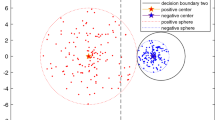Abstract
Distance metric learning aims to find an appropriate method to measure similarities between samples. An excellent distance metric can greatly improve the performance of many machine learning algorithms. Most previous methods in this area have focused on finding metrics which utilize large-margin criterion to optimize compactness and separability simultaneously. One major shortcoming of these methods is their failure to balance all between-class scatters when the distributions of samples are extremely unbalanced. Large-margin criterion tends to maintain bigger scatters while abandoning those smaller ones to make the total scatters maximized. In this paper, we introduce a regularized metric learning framework, metric learning with geometric mean which obtains a distance metric using geometric mean. The novel method balances all between-class scatters and separates samples from different classes simultaneously. Various experiments on benchmark datasets show the good performance of the novel method.






Similar content being viewed by others
References
Baghshah M S, Shouraki SB (2009) Semi-supervised metric learning using pairwise constraints [C]. In: IJCAI, vol 9, pp 1217–1222
Cover TM, Thomas JA (2012) Elements of information theory [M]. Wiley, New York
Davis JV, Dhillon IS (2008) Structured metric learning for high dimensional problems [C]. In: Proceedings of the 14th ACM SIGKDD international conference on Knowledge discovery and data mining. ACM, pp 195–203
Davis JV, Kulis B, Jain P et al (2007) Information-theoretic metric learning [C]. In: Proceedings of the 24th international conference on machine learning. ACM, pp 209–216
Duda RO, Hart PE, Stork DG (2012) Pattern classification [M]. Wiley, New York
Feng L, Wang H, Liu S et al (2015) Locality structured sparsity preserving embedding [J]. Int J Pattern Recognit Artif Intell 29(06):1551010
Goldberger J, Hinton GE, Roweis ST et al (2004) Neighbourhood components analysis. In: Advances in neural information processing systems, pp 513–520
Hoi SC, Liu W, Chang SF (2010) Semi-supervised distance metric learning for collaborative image retrieval and clustering [J]. ACM Trans Multimed Comput Commun Appl (TOMM) 6(3):18
Huang K, Ying Y, Campbell C (2011) Generalized sparse metric learning with relative comparisons [J]. Knowl Inf Syst 28(1):25–45
Lee JH, McDonnell KT, Zelenyuk A et al (2014) A structure-based distance metric for high-dimensional space exploration with multidimensional scaling [J]. Vis Comput Gr IEEE Trans 20(3):351–364
Liu W, Tian X, Tao D et al (2010) Constrained metric learning via distance gap maximization [C]. In: AAAI
Ma L, Yang X, Tao D (2014) Person re-identification over camera networks using multi-task distance metric learning [J]. Image Process IEEE Trans 23(8):3656–3670
Niyogi X (2004) Locality preserving projections [C]. In: Neural information processing systems, vol 16. MIT, p 153
Noorbehbahani F, Mousavi SR, Mirzaei A (2015) An incremental mixed data clustering method using a new distance measure [J]. Soft Comput 19(3):731–743
Roweis ST, Saul LK (2000) Nonlinear dimensionality reduction by locally linear embedding [J]. Science 290(5500):2323–2326
Schölkopf B, Smola AJ (2002) Learning with kernels: support vector machines, regularization, optimization, and beyond [M]. MIT press, Cambridge
Shao C, Song X, Yang X et al (2015) Extended minimum-squared error algorithm for robust face recognition via auxiliary mirror samples [J]. Soft Comput. doi:10.1007/s00500-015-1692-7
Shental N, Hertz T, Weinshall D (2002) Adjustment learning and relevant component analysis [M]. In: Computer vision-ECCV 2002. Springer. Berlin, Heidelberg, pp 776–790
Tao D, Li X, Wu X et al (2009) Geometric mean for subspace selection [J]. Pattern Anal Mach Intell IEEE Trans 31(2):260–274
Wang F (2011) Semisupervised metric learning by maximizing constraint margin [J]. Syst Man Cybern Part B: Cybern IEEE Trans 41(4):931–939
Wang S, Jin R (2009) An information geometry approach for distance metric learning [C]. In: International conference on artificial intelligence and statistics, pp 591–598
Wei J, Zeng Q, Wang X et al (2014) Integrating local and global topological structures for semi-supervised dimensionality reduction [J]. Soft Comput 18(6):1189–1198
Weinberger KQ, Blitzer J, Saul LK (2005) Distance metric learning for large margin nearest neighbor classification [C]. In: Advances in neural information processing systems, pp 1473–1480
Wold S, Esbensen K, Geladi P (1987) Principal component analysis [J]. Chemometr Intell Lab Syst 2(1):37–52
Xing EP, Jordan MI, Russell S et al (2002) Distance metric learning with application to clustering with side-information [C]. In: Advances in neural information processing systems, pp 505–512
Ying Y, Huang K, Campbell C (2009) Sparse metric learning via smooth optimization [C]. In: Advances in neural information processing systems, pp 2214–2222
Yu J, Tao D, Li J et al (2014) Semantic preserving distance metric learning and applications [J]. Inf Sci 281:674–686
Acknowledgments
This study was funded by National Natural Science Foundation of People’s Republic of China (61173163, 61370200). Huibing Wang, Lin Feng and Yang Liu declare that they have no conflict of interest. This article does not contain any studies with human participants or animals performed by any of the authors.
Author information
Authors and Affiliations
Corresponding author
Additional information
Communicated by A. Di Nola.
Rights and permissions
About this article
Cite this article
Wang, H., Feng, L. & Liu, Y. Metric learning with geometric mean for similarities measurement. Soft Comput 20, 3969–3979 (2016). https://doi.org/10.1007/s00500-015-1985-x
Published:
Issue Date:
DOI: https://doi.org/10.1007/s00500-015-1985-x




